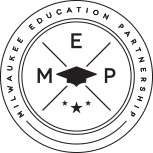
History of the Milwaukee Partnership Academy
The Milwaukee Partnership Academy (MPA) was formed in April 1999 as an Urban P 16 Council for Quality Teaching and Learning when several of the core partners jointly applied for a Title II grant from the U.S. Department of Education. The overarching goal of the Title II grant was to develop a comprehensive teacher education prototype to prepare K-12 teachers to teach in an urban school setting through a strong and unique partnership.
The partnership’s initial focus was to improve the education of children through better preparation, recruitment and retention of teachers. That focus remained and evolved into a much broader initiative.
As the partnership continued to expand, the partners developed a common mission for children and identified specific areas in which they could jointly work on and take ownership. The broad initiative of the Milwaukee Partnership Academy was to assure that every child in Milwaukee Public Schools is performing at or above grade level in reading, writing, and mathematics through shared responsibility for student success.
In May 2002, the MPA formally announced its goals to the community at a press conference involving leadership from all the core partners as well as state and local government officials. In the fall of 2002, after more than a year of collaborative work, the MPA launched a number of significant initiatives in Milwaukee Public Schools. These included:
- Introduction of a balanced literacy framework, a research-proven reading method, as a guide for teaching literacy across all subject areas (and years later, a comprehensive literacy framework)
- A network of school-based literacy coaches to lead the school-based efforts to promote comprehensive literacy
- New, user-friendly reports to help teachers, administrators and parents monitor student progress
- Planning for a community-wide tutoring and family literacy effort
During the 2002-2003 school year, the MPA continued to work to develop these initiatives while focusing on other collaborative efforts to expand and support the goals of improving teacher education and student learning in all subject areas. An executive director was hired to direct and lead the MPA’s work, and the MPA aligned its goals more closely with the long-range goals of Milwaukee Public Schools.
Through the years beginning in the summer of 2003, the collaborative efforts of the MPA Partners helped bring in a number of significant new resources to support efforts to improve student achievement. These included a $20 million grant from the National Science Foundation to improve mathematics teaching and learning; a $17.25 million grant from the Bill and Melinda Gates Foundation to redesign public high schools; a $5 million Carnegie Corporation grant to improve teacher education; a $300,000 grant from the Milwaukee-based Herzfeld Foundation to support ten of the school-based learning teams; and a $3.1 million grant from the National Education Association Foundation to close the achievement gaps in Milwaukee Public Schools. The MPA was also instrumental in acquiring the more than $14 million in match that created the $28 million GEAR UP (Gaining Early Awareness & Readiness) award from the U.S. Department of Education in 2011, providing seven years of support for MPS towards improving high school education and college aspirations, readiness and access for more than 2,700 middle school students.
In addition, the MPA presentation at the Workforce Innovations 2005 Conference in Philadelphia on ways the MPA was improving education and workforce development programs through partnerships resulted in a partner organization--the Greater Milwaukee Committee--receiving a $5 million grant from the U.S. Department of Labor focused on developing employment and training programs in Milwaukee.
The MPA worked on various projects and implemented a number of initiatives including Learning Teams, Literacy Specialists, Literacy Coaches, Math Teaching Specialists, Math Teacher Leaders and Teacher Induction. For additional information on these and some of the other major projects, please visit our page on MPA Initiatives.
Over the years, there were a number of changes in top leadership at Milwaukee Public Schools and other core partner organizations as well as with state and community officials. New leaders emerged and committed to the MPA’s work. The partnership always adjusted to the changes and continued the work of helping all children achieve.
In November 2013, the Milwaukee Partnership Academy officially changed its name to the Milwaukee Education Partnership, Inc. (MEP) in order to better reflect its comprehensive mission and collaborative approach. In addition, the MEP attained status as a 501(c)(3) organization.
For more information on the history of the MPA, refer to the following:
Pugach, M.C., Post, L.M., Anderson, C., Lehmann, R., & Donder, D.J. (2006). System-to-System Partnership as a Reform Strategy for Urban Schools. In J.L. Kinchele, K. Hayes, K. Rose, & P. Anderson (Eds.) The Praeger Handbook of Urban Education, Volume 2 (pp. 555-565). Westport: Greenwood.


